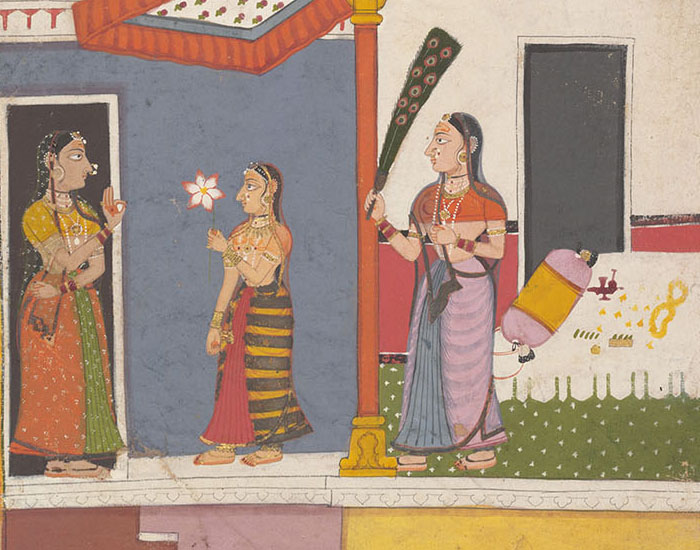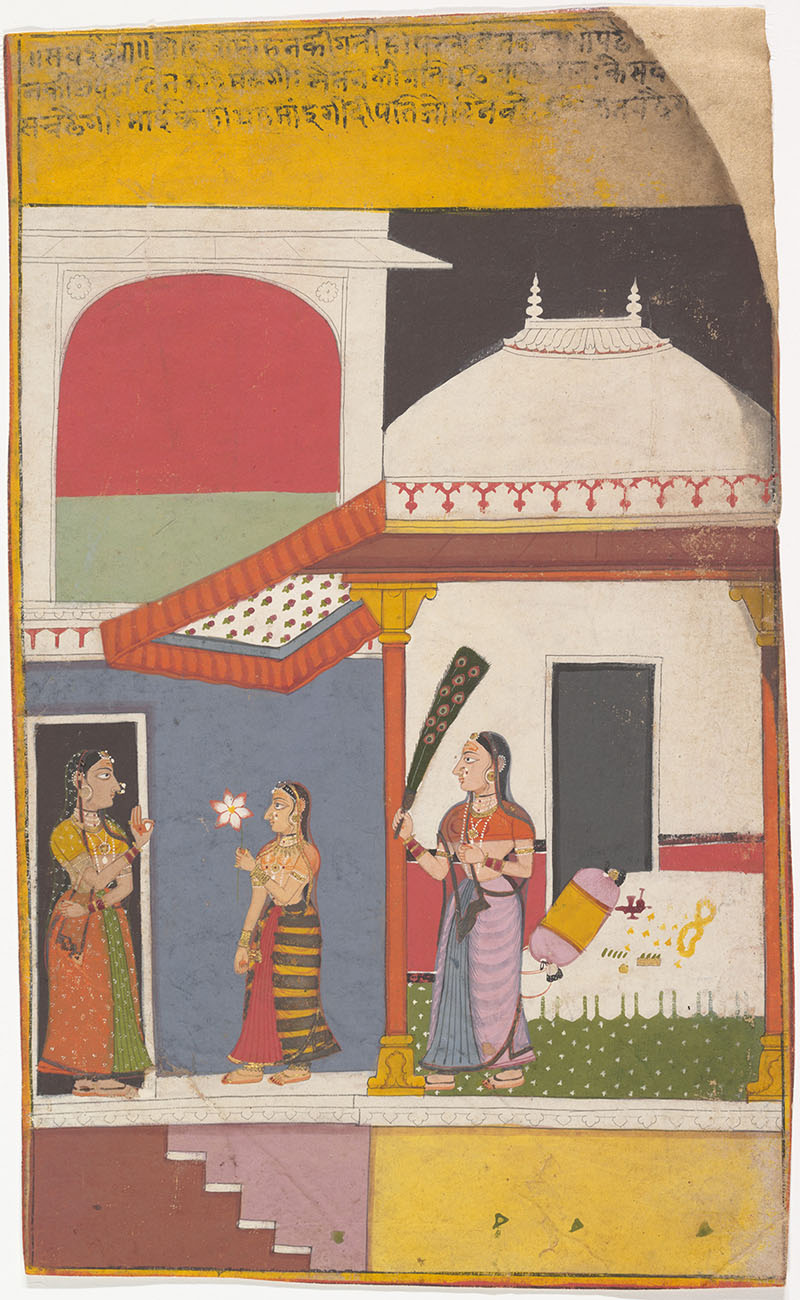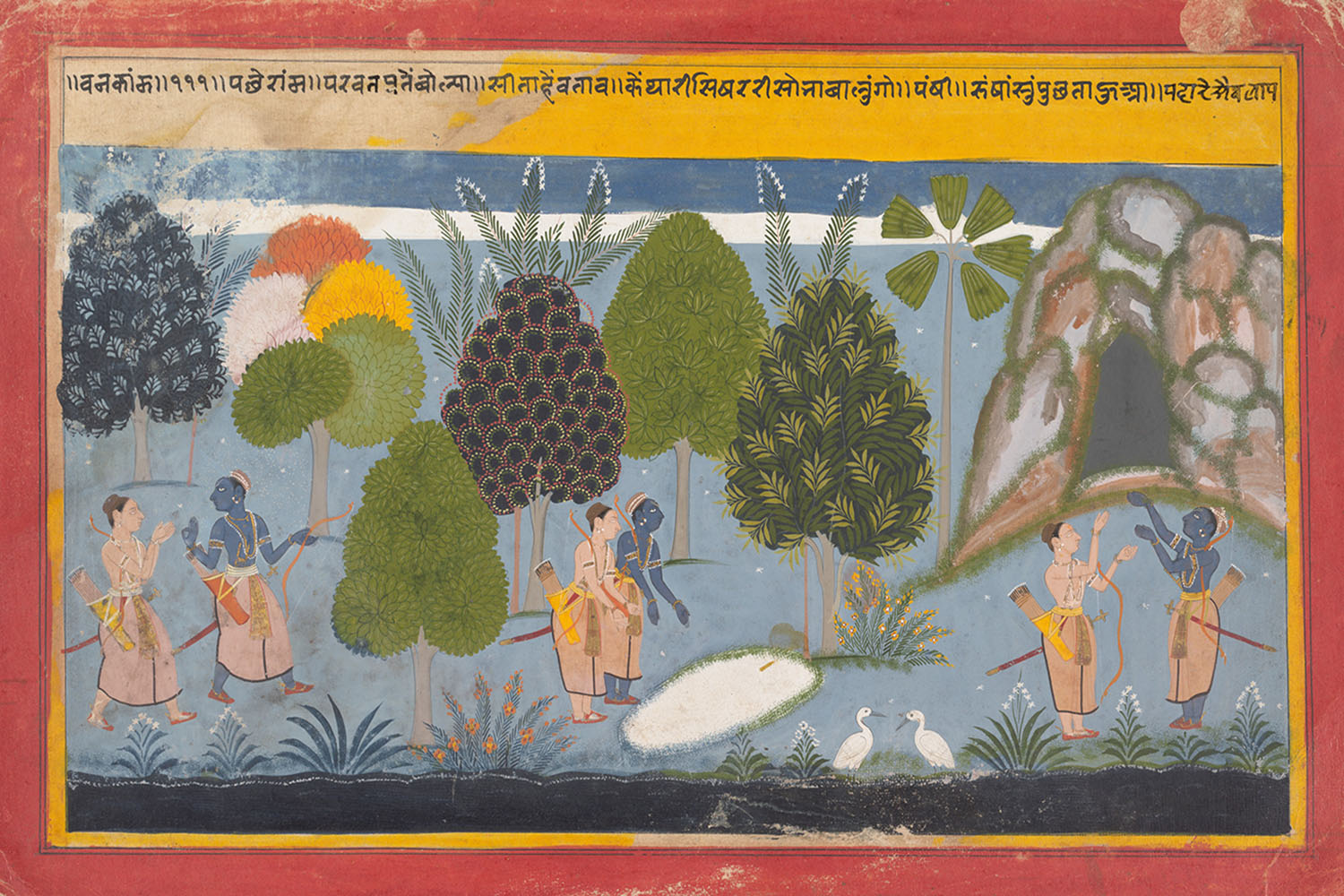Encyclopedia of Art > Articles
Mewar School of Painting

A tradition of painting that emerged between the seventeenth and eighteenth centuries, the Mewar school of painting was patronised by the Sisodia Dynasty in the Rajput state of Mewar. The prolific court workshops of Mewar produced paintings that spanned several genres and fused diverse artistic influences with its own style.
Due to the prominence of Jainism in the region, and the associated Western Indian style of painting, the practice of manuscript illustration was well-established in the Mewar state. Early illustrated Jain texts dating to the fifteenth century in Mewar followed the conventions of the Jain style, characterised by its unique silhouettes, protruding eyes and saturated colour palette.
The earliest dated manuscript associated with the Mewar school of Rajput painting is the Chawand Ragamala series (1605), painted by the artist Nasiruddin. Chawand was the temporary capital of the state during its conflicts with the Mughals in the late sixteenth and early seventeenth centuries. According to scholars, this ragamala – which was possibly commissioned by a member of the court – reflects an evolution of the early Rajasthani style of painting. It is notable for its noticeably less angular depiction of human forms and its vertical format, which was likely a direct result of Mughal and Islamic influences, along with its deeply symbolic iconography and the use of colours similar to chaurapanchasika paintings.
An accord with the Mughal empire in 1614–15 spurred a period of prosperity in Mewar, particularly during the reigns of Karan Singh and his son Jagat Singh I. The latter was a distinguished patron of painting and commissioned several illustrated manuscripts with the intention of replenishing the royal library, whose collection had been damaged during the siege of Chittor in 1567–68. These manuscripts spanned different genres, from religious and secular poetry to historical and genealogical texts.
Dominating the Mewar workshop was the master artist Sahibdin, who produced works across genres. Some of his works include the Ragamala series (1628), the Rasikapriya series (1630), the Gita Govinda (1628, 1635), the Bhagavata Purana (1648) and, most notably, the Ramayana (1649–53). The Mewar Ramayana is considered one of the most ambitious projects of the Mewar school. Six of the seven books of the Ramayana were completed by three groups of artists led by Sahibdin and another artist known as Manohar. Sahibdin’s expressive style – which drew from Rajasthani painting traditions as well as the more popular Mughal school – continued to define the template for manuscript illustration in the court workshop for several decades. Another large-scale manuscript project was the Mahabharata, executed in the final decades of the seventeenth century. However, this is not considered as technically adept as the Mewar Ramayana.
Between the reigns of Raj Singh and Jai Singh, which spanned the latter half of the seventeenth century, portraiture emerged as a significant genre in Mewar. The early eighteenth century saw the appearance of a new style of portraits, credited to an anonymous artist now known by the epithet of Stipple Master. These were characterised by a limited colour palette, a minimal background and the use of stippled greys to achieve highlight and shading. This style, which resembled the nim qalam technique of the Mughal and Deccan styles, fell out of vogue by the first quarter of the eighteenth century.
In the following two decades, under the reign of Sangram Singh II, manuscript illustration underwent a revival. Some of the prominent manuscripts illustrated during this time include Sat Sai (1719), a seventeenth-century work of verse composed by the poet Bihari Lal (painted in 1719), and Sur Sagar (c. 1725–1735), the sixteenth-century work of devotional poetry attributed to Surdas. The reigns of Sangram Singh II and his successor Jagat Singh II are considered the last significant phase of manuscript painting within the Mewar school. This phase was also characterised by the emergence of the genre now known as tamasha painting. Executed on large sheets of paper by two or three artists, these paintings recorded – in panoramic scope and fine detail – hunts, festivals and a variety of court scenes. The eighteenth century also saw the emergence of the Nathdwara sub-school in Mewar painting, which focussed on devotional themes. Centred around the Shrinathji Temple, a Vaishnava pilgrimage site in Nathdwara, these paintings were primarily executed on cloth and incorporated elements from the painting styles of several Rajasthani courts.
Due to political flux, painting in the court at Udaipur declined in the second half of the eighteenth century, with several artists leaving the workshop altogether. One such artist was Bagta, who moved to the thikana of Deogarh, which was administered by the Rawat clan, who were members of Mewar’s nobility. Bagta was renowned for his innovative style, which challenged the conventions of court painting of the time. Apart from carefully studied portraits of the Rawat rulers, he also painted exquisite scenes in which the landscape was represented through an aerial view, similar to the works produced in Udaipur. His son Chokha carried forward his style of painting in the early years of the nineteenth century.
The remainder of the nineteenth century, marked by the increasing political influence of the British in the region, did not add considerably to the artistic legacy of the Mewar school. Paintings continued to follow the conventions set a century earlier. A brief artistic evolution occurred in the second half of the nineteenth century, spurred by the visits of British artists such as William Carpenter, Val Prinsep and Marianne North. However, by this time the manuscript painting tradition in Udaipur had waned significantly and, eventually, court portraiture went on to be replaced by photography.
First Published: April 21, 2022
Last Updated: July 26, 2023




